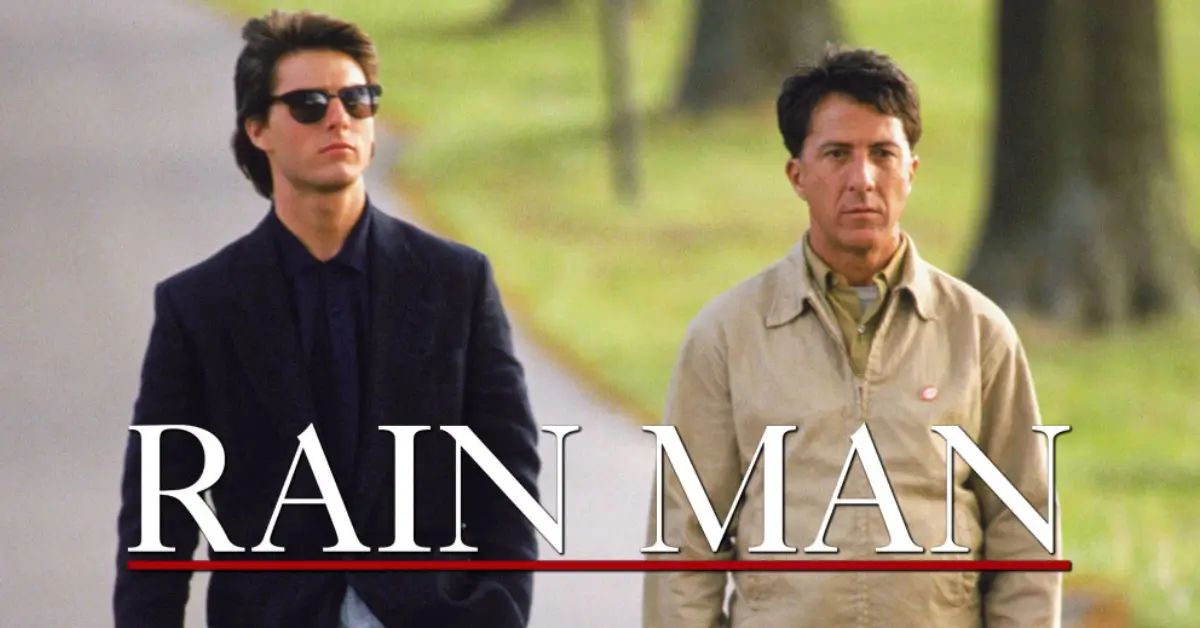Rain Man: Autism on Screen and Its Revolutionary Impact on Public Awareness
Few films have shaped public understanding of a neurological condition as profoundly as “Rain Man.” This landmark film brought autism into mainstream consciousness at a time when the condition was poorly understood and rarely discussed in popular culture. Through its compelling narrative of two brothers one neurotypical, one autistic “Rain Man” offers a nuanced exploration of neurodiversity, family dynamics, and personal growth. While some aspects of its portrayal may appear dated by today’s standards, the film’s lasting impact on autism awareness and representation in cinema remains undeniable.
Thank you for reading this post, don't forget to subscribe!Basic Film Information
Title: Rain Man
Release Date & Production Year: December 16, 1988
Director: Barry Levinson, known for character-driven films exploring human relationships and family dynamics
Screenwriter: Ronald Bass and Barry Morrow, with Morrow basing the character of Raymond partially on real-life savant Kim Peek
Main Cast & Characters:
- Dustin Hoffman as Raymond Babbitt, an autistic savant with extraordinary mathematical abilities
- Tom Cruise as Charlie Babbitt, Raymond’s self-centered younger brother
- Valeria Golino as Susanna, Charlie’s girlfriend
- Jerry Molen as Dr. Bruner, Raymond’s psychiatrist and guardian
- Jack Murdock as John Mooney, the Babbitt family attorney
- Michael D. Roberts as Vern, the sympathetic caregiver at Wallbrook
Genre: Drama/Road Film
Awards Won: Academy Awards for Best Picture, Best Director, Best Actor (Hoffman), and Best Original Screenplay; Golden Globes for Best Motion Picture – Drama and Best Actor (Hoffman)
Runtime & Rating: 133 minutes, Rated R for language (though by modern standards it would likely receive a PG-13 rating)
Plot Summary
General Overview
“Rain Man” follows Charlie Babbitt, a struggling luxury car dealer who discovers that his estranged father has died, leaving his $3 million estate to an unknown beneficiary. Charlie traces the money to his brother Raymond, whose existence he had forgotten. Raymond, an autistic man with savant abilities, lives in a residential care facility. Initially planning to gain custody of Raymond solely to leverage his half of the inheritance, Charlie kidnaps his brother and embarks on a cross-country road trip. Through their journey, Charlie’s perspective transforms from seeing Raymond as a burden to developing genuine brotherly affection and respect.
Mental Health Themes
The film primarily explores autism spectrum disorder, particularly focusing on the savant syndrome that affects a small percentage of autistic individuals. Raymond displays classic autism symptoms including adherence to strict routines, difficulty with interpersonal relationships, sensory sensitivities, and communication challenges. However, he also possesses extraordinary abilities in mathematics, memory, and pattern recognition. The film also touches on institutionalization, the ethics of guardianship, and the importance of consistent, supportive care for individuals with special needs.
Key Turning Points
Several pivotal moments highlight Raymond’s condition and Charlie’s evolving understanding: Raymond’s meltdown when his routine is disrupted; his unexpected comfort with Charlie after recognizing him as “Rain Man” (a childhood mispronunciation of “Raymond”); his impressive demonstration of memory at a Las Vegas casino; and Charlie’s ultimate decision to prioritize Raymond’s well-being over his financial interests. Each moment reveals different facets of autism while advancing the brothers’ relationship.
Ending Analysis
The film concludes with Charlie returning Raymond to Wallbrook institution after realizing that, despite their newfound connection, Raymond requires the structured environment and specialized care that Charlie cannot provide. The bittersweet ending avoids the Hollywood cliché of a miraculous “cure” or perfect resolution. Instead, it offers a realistic acknowledgment of Raymond’s ongoing needs while showing Charlie’s growth from selfishness to genuine care. The promise of regular visits suggests a continued relationship that respects Raymond’s requirements while maintaining their fraternal bond.
Setting & Cinematic Techniques
Filming Locations
The cross-country road trip takes viewers through various American landscapes from Cincinnati to Las Vegas and Los Angeles creating a journey of both physical and emotional discovery. Particularly significant settings include the Wallbrook institution with its structured, protective environment; the various hotels that highlight Raymond’s difficulty adapting to new surroundings; and the desert highways that provide visual metaphors for Charlie’s internal journey.
Cinematography
Cinematographer John Seale employs techniques that subtly reflect Raymond’s perspective and the brothers’ evolving relationship. The camera work shifts from disconnected, separate framing of the brothers in early scenes to more intimate, shared frames as their relationship develops. Lighting transitions from the institutional fluorescence of Wallbrook to the natural light of the open road, symbolizing Raymond’s temporary freedom and Charlie’s growing illumination about his brother’s condition.
Sound & Music
Hans Zimmer’s Oscar-nominated score balances emotional depth with restraint, avoiding manipulative sentimentality while enhancing key moments. The soundtrack features period-appropriate songs that complement the road trip atmosphere. Sound design plays a crucial role in communicating Raymond’s sensory sensitivities heightened sounds during his moments of distress help viewers experience his overwhelm, particularly during his meltdowns.
Acting & Character Portrayal
Lead Actor’s Performance
Dustin Hoffman’s Oscar-winning portrayal of Raymond Babbitt represents one of cinema’s most studied performances of neurodivergence. Hoffman spent a year researching autism, working with autism specialists and meeting people on the spectrum. His performance captures Raymond’s restricted emotional expression, distinctive speech patterns, physical mannerisms, and adherence to routine without caricature. While some aspects may appear somewhat stylized by today’s standards, Hoffman’s commitment to authenticity set a new benchmark for portraying neurological conditions on screen.
Supporting Cast
Tom Cruise delivers a nuanced performance as Charlie, convincingly portraying his character’s evolution from selfish opportunist to caring brother. Valeria Golino’s Susanna provides an important counterpoint to Charlie’s initial callousness, modeling compassionate interaction with Raymond. Jerry Molen as Dr. Bruner represents institutional care with complexity rather than villainy, presenting a genuine concern for Raymond’s wellbeing that ultimately aligns with Charlie’s transformed perspective.
Accuracy & Authenticity
For its time, “Rain Man” achieved remarkable authenticity in portraying autism, particularly given the limited public understanding of the condition in the 1980s. Hoffman’s performance incorporates many clinically accurate behaviors: echolalia (repeating phrases), adherence to strict routines, difficulty with eye contact, and sensory sensitivities. However, the film’s focus on Raymond’s savant abilities exceptional mathematical calculation and memory represents a rare manifestation that affects only about 10% of autistic individuals, potentially creating a skewed impression of autism in the public mind.
Mental Health Representation: Strengths & Weaknesses
Psychological Accuracy
The film’s portrayal of autism reflects the clinical understanding of the late 1980s, focusing primarily on observable behaviors rather than internal experiences. Modern viewers may notice the absence of more contemporary insights about autism as a spectrum condition with varied presentations. Raymond’s character aligns with what was then called “classic autism” or “Kanner’s syndrome,” characterized by significant social and communication challenges. His savant abilities, while dramatically compelling, represent an exceptional rather than typical autistic trait.
Stigmatization vs. Awareness
“Rain Man” made significant strides in destigmatizing autism by portraying Raymond as a fully human character with dignity rather than as an object of pity or fear. The film avoids simplistic “magical disabled person” tropes by showing Raymond’s genuine challenges alongside his abilities. However, the emphasis on savant skills unintentionally contributed to the “autism as superpower” stereotype that can minimize the real difficulties many autistic people face. The film’s lasting achievement lies in humanizing a condition that was previously misunderstood or hidden from public view.
Impact on Public Perception
The film dramatically increased public awareness of autism, becoming many viewers’ first exposure to the condition. In the years following its release, autism diagnosis rates and research funding increased significantly. While correlation doesn’t equal causation, “Rain Man” undeniably brought autism into public consciousness. Dr. Darold Treffert, an expert on savant syndrome who consulted on the film, noted that “Rain Man” did more to increase autism awareness than any scientific paper had done previously.
Critical Reception & Awards
Critics’ Reviews
“Rain Man” received overwhelmingly positive reviews, with particular praise for Hoffman’s performance and the film’s handling of a sensitive subject. Roger Ebert awarded it four stars, commending its refusal to sentimentalize Raymond’s condition. Some critics noted the creative liberties taken with autism portrayal, but most acknowledged the film’s good intentions and positive impact. Over time, critical assessment has evolved to recognize both the film’s groundbreaking representation and its limitations in light of modern understanding.
Audience Reactions
The film resonated strongly with general audiences, becoming the highest-grossing film of 1988. Families affected by autism had mixed responses many appreciated the mainstream visibility while others noted discrepancies between Raymond’s presentation and their lived experiences. The film sparked unprecedented public interest in autism, with many parents seeking evaluations for children after recognizing similarities to Raymond’s behaviors.
Awards & Nominations
Beyond its four Academy Awards (Picture, Director, Actor, and Original Screenplay), “Rain Man” received widespread recognition from the Golden Globes, BAFTA, and numerous critics’ organizations. The film’s overwhelming awards success demonstrated both its artistic achievement and its powerful social impact, solidifying its place in cinema history.
Cultural & Social Impact
Discussions Sparked
“Rain Man” generated unprecedented public conversation about autism, challenging prevailing notions that autism was a result of “refrigerator mothers” or poor parenting. The film opened discussions about neurodiversity, special education needs, and the capabilities of autistic individuals. It also raised important questions about institutional care versus family-based support questions that continue to resonate in disability advocacy.
Influence on Other Films
The film established a template for more thoughtful portrayal of developmental conditions in mainstream cinema, influencing later works like “I Am Sam,” “The Accountant,” “Adam,” and “Mozart and the Whale.” Its commercial and critical success demonstrated that films centered on neurodivergent characters could achieve mainstream appeal, paving the way for more diverse representation in subsequent decades.
Mental Health Advocacy
“Rain Man” had a quantifiable impact on autism advocacy and research funding. Organizations like Autism Speaks and the Autism Society of America noted increased interest and support following the film’s release. The character of Raymond became a cultural touchpoint that, while not without problematic aspects, helped validate the experiences of countless families affected by autism and reduced the stigma surrounding the condition.
Personal Reflection & Final Thoughts
“Rain Man” provides profound insight into how neurotypical society often struggles to accommodate neurodivergent individuals, requiring them to adapt rather than modifying environments to meet their needs. The film’s greatest strength lies in showing Charlie’s transformation from seeing Raymond as broken or lesser to recognizing his brother’s different yet valid way of experiencing the world.
I would recommend this film to someone connected to autism with the caveat that it represents an understanding of autism from the 1980s and focuses on a particular presentation that doesn’t represent the full spectrum. For viewers without prior knowledge of autism, I would suggest pairing it with more contemporary portrayals or resources to provide a more complete picture.
The film could have improved its portrayal by exploring Raymond’s internal experience rather than primarily viewing him through Charlie’s perspective. Additionally, including autistic input in the creative process (now standard practice for responsible representation) would have added authenticity. However, judged within its historical context, “Rain Man” represented a revolutionary step forward in autism visibility.
Conclusion
More than three decades after its release, “Rain Man” remains a watershed moment in cinema’s portrayal of neurodevelopmental conditions. Though our understanding of autism has evolved significantly, the film’s enduring legacy lies in its humanizing approach to a previously misunderstood condition and its powerful message about accepting neurological differences.
By avoiding both demonization and idealization of autism, “Rain Man” created space for more nuanced conversations about neurodiversity. Its lasting cultural impact extends beyond entertainment value to measurable social change increasing autism awareness, challenging stigma, and encouraging a more inclusive understanding of the diverse ways human minds can function.
What are your thoughts on this film’s portrayal of autism? Has your understanding of autism spectrum conditions evolved since first watching “Rain Man”?

